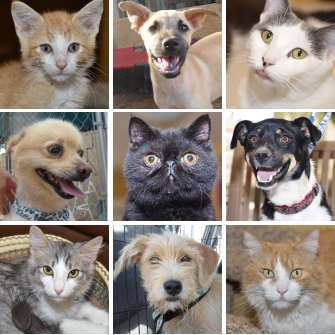Introducing a Dog to a Resident Cat
When introducing your foster dog/puppy to a resident cat it is important that your foster dog/puppy knows basic obedience.
(So wait a couple of days—until you’ve started some basic training and formed an understanding with your foster dog/puppy—to introduce it to your resident cat.) Let your foster dog/puppy settle down and get to know you and its surroundings first before you start introductions to small, furry creatures. Keep your cat in a special room. You will need to have your foster dog/puppy under control when interacting with your resident cat so it can learn which behaviors are appropriate and which ones are not.
Introducing a cat to a dog is similar to introducing dogs to one another.
Take your time and create a stress free environment. Without letting the cat and dog actually meet, you will want to start by keeping the cat separate. Set the dog/puppy up in its own room and allow it to become comfortable. Once it is comfortable in the room, let it explore the rest of the house for short periods each day while the cat is not there.
Then bring the cat into the room and keep the dog on leash. Observe their interactions. A dog that is showing overt aggression, such as snarling, growling baring teeth, etc., will probably never accept a cat. The cat and dog should be separated by baby gates or kept in separate rooms.
If all is reasonably calm so far, walk the dog/puppy around the room on leash. Let the dog/puppy go wherever it wants, but don’t let go of the leash in case it decides to chase the cat. On-leash interactions give the cat the opportunity to approach the dog if it chooses, or to find its own route of escape. During the first few meetings the cat and dog will probably not interact face to face.
A dog is a predatory animal. It is a natural instinct for a dog to want to chase a cat. Assume that the dog will chase the cat—so that you are prepared. Do not ever let the dog intimidate the cat by barking or chasing. Use a lead and collar and give a quick, sideways tug and say “Leave it!” each time the dog acts inappropriately to let it know these behaviors are unacceptable.
On the other hand, if the cat bops the dog on the nose as a warning, that is a good sign and should not be discouraged. When they set up boundaries between themselves, they are beginning to establish a working relationship. Let the cat interact with the dog on leash for about one half hour, then return the cat back to its safe haven and bring the dog/puppy to its crate or bed. Give the dog/puppy a treat and lots of praise. Increase the amount of time they are together a little each visit.
It is important to be patient and encouraging in their interactions. If you are relaxed, they too will be more at ease. Always praise friendly behavior profusely. Don’t try to rush the introduction or force them to interact more than either of them are willing. Pressing them to accept each other will only slow down the adjustment process. When the cat and dog seem to be getting used to each other, let the dog go, but keep its leash attached to its collar. Let the dog/puppy drag the leash around the house as it wanders. That way you can get control of the dog/puppy at any time. The cat will probably hide at first. You should use your best judgment as to when they can begin supervised sessions with the dog/puppy off-leash.




